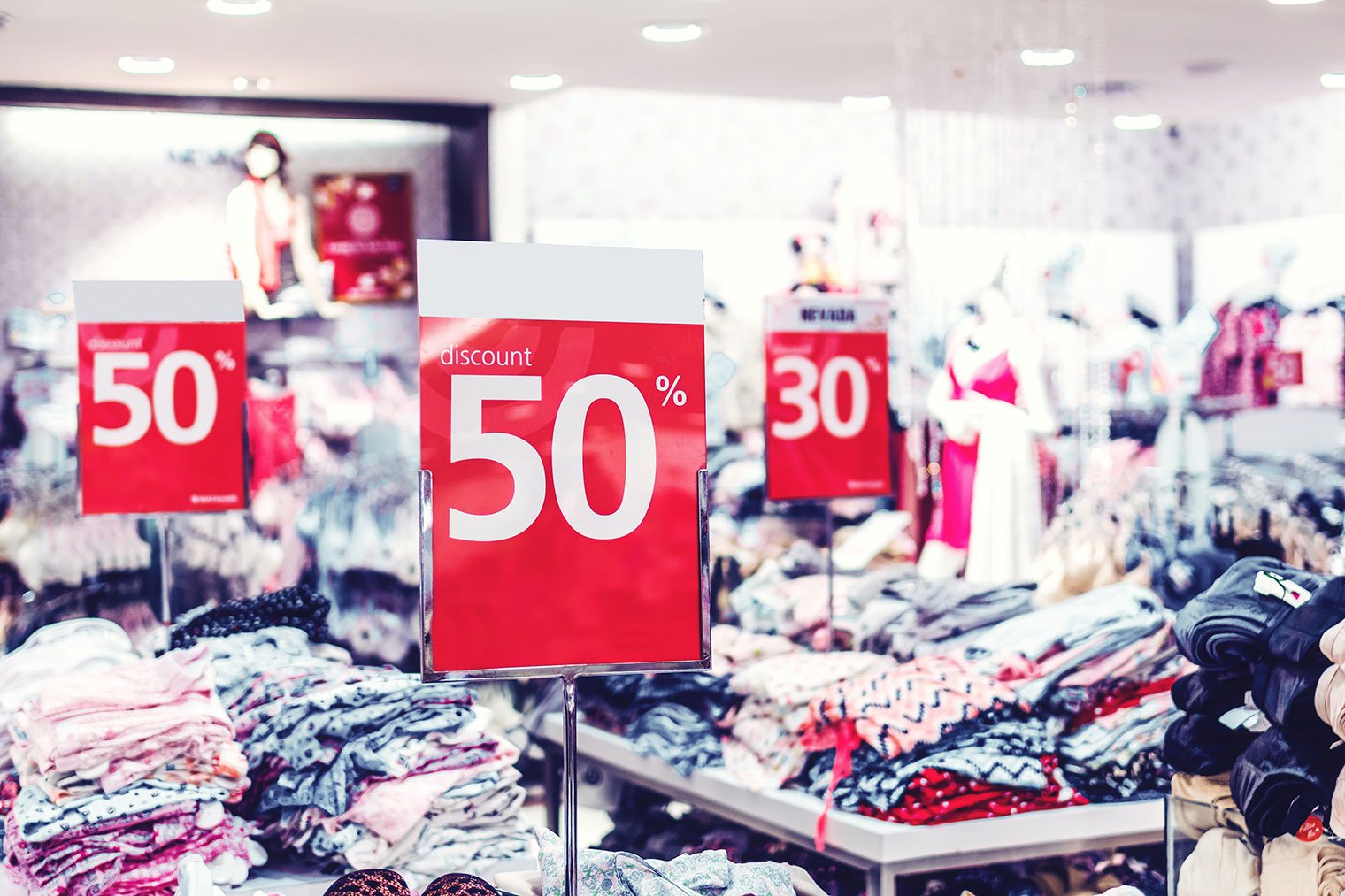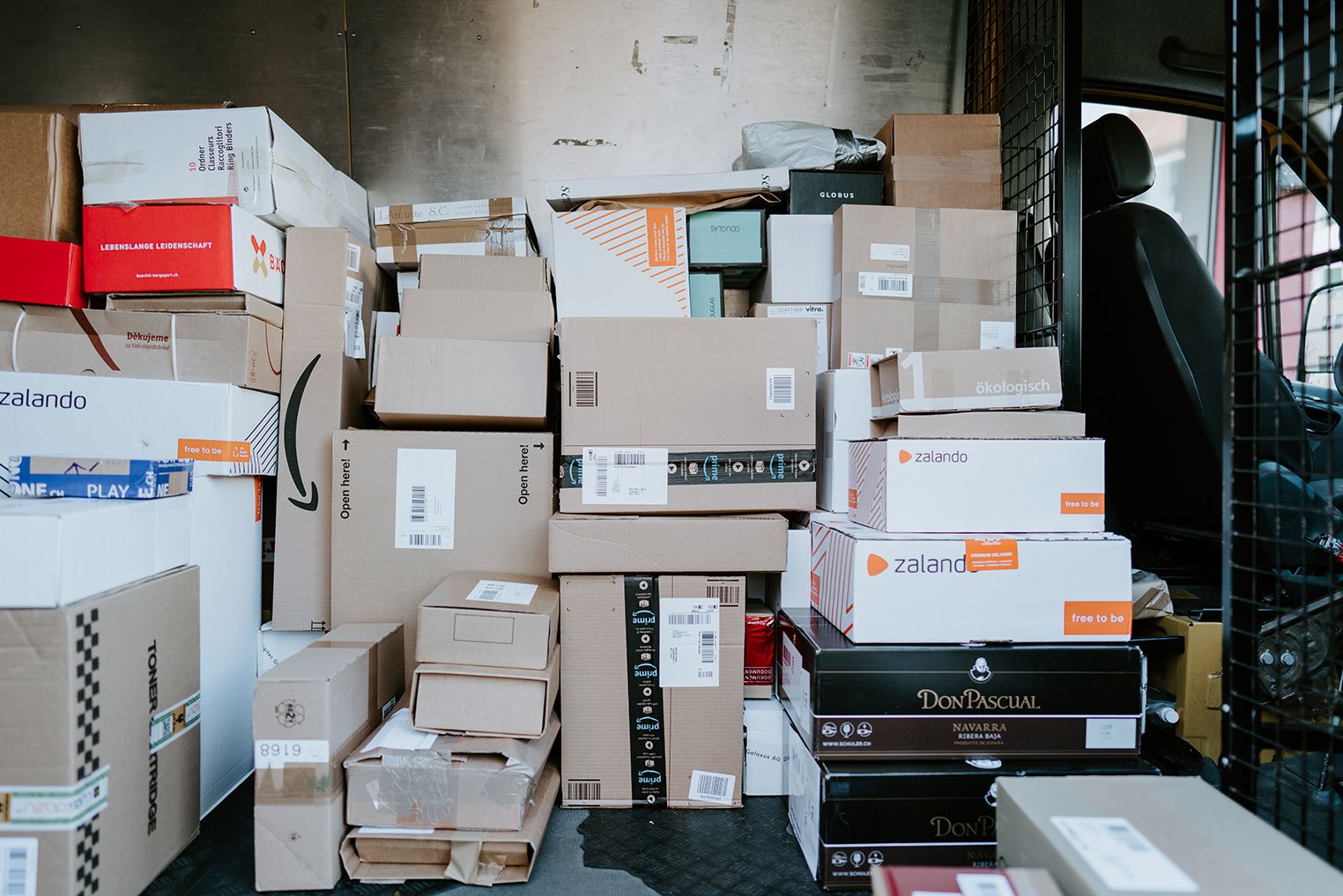In the previous article in our Climate Conscious Commerce blog series, we looked at Green UX practices that can be used on e-commerce sites to inform and support customers to make more sustainable purchases. In this article we will look at the infrastructure around e-commerce, focusing on delivery, packaging, and data. E-commerce relies on many services and products to be able to package and deliver their goods to their customers. As e-commerce has grown, so have these services. There is a huge potential here to reduce the environmental impact of e-commerce and make customers more aware of the environmental implications of their purchases from cradle-to-door. We spoke to logistics expert Martin Jungerts to help us gain a deeper insight into the current challenges and opportunities. Today, Martin works as a logistics consultant, and he has previously held positions at Swedish food retailer Coop and Swedish fashion retail group RNB Retail and Brands.
The last mile
The last-mile describes the complex and expensive last part in the transportation of packages from hubs to final destinations. There is a myriad of delivery options that a customer can choose from when buying online. Swedish pharmacy Apoteket has nine options to choose from, e.g. 1–2-day delivery to your postbox, express collect at store, evening delivery by courier, express home delivery by courier, home delivery by courier, collect at store, collect at a parcel box, collect at a delivery point (phew!) So which option is the greenest? Martin Jungerts believes it is very hard to say which is the best choice. “It very much depends on the context – who is the customer, what type of products are ordered and where does the customer live? It is impossible to say that 'option X is always the greenest one.' For example, home delivery in cities could be the most environmentally friendly since you can provide them by bicycle or electric vehicles. At the same time, it could be the worst option in the countryside if you are delivering one package over a long distance. Pick-up-at-store could be efficient, if the store is close to the customer’s workplace, but inefficient if the customer needs to take his or her car just for the order pick-up. What I can say is that consolidation is good. Any option where you can consolidate as many shipments as possible in one delivery or one truck will inevitably create less emissions per package. So, you could argue that pick-up-points or parcel boxes are options where your delivery is consolidated with quite a lot of other deliveries. The delivery companies put them in locations where they know that they can aggregate a certain number of orders.” These options are most effective if they are in a location that is close to you or somewhere you pass. “The possibility for the customer to choose which pick-up location they want their order delivered to is a way to nudge towards sustainability since they are most likely to choose an option that is close to them.”
The focus for e-commerce has been fast and free deliveries to as many customers as possible, the consumer has been spoilt. No-rush deliveries could be an alternative, allowing more orders to be aggregated and delivered to the same area or customer. But how willing are customers to change their behaviour and how effective is this option? “Focus is now shifting, but to be honest it goes too slow. Sure – there are surveys showing that 40–50% of consumers are more likely to shop with a retailer that offers sustainable delivery options, but it very much depends on how you pose the question. For example, when Swedish postal company Postnord asked how customers would rank different delivery options for their 2021 Q3 E-barometern, the “sustainable” option with a longer lead time finished last – the “flexible,” “fast,” and “precise” options were all more popular. And Sweden is quite a progressive country when it comes to sustainability awareness. Thus, the willingness to choose greener deliveries has a limit. Therefore, I believe that a certain amount of incentivising and nudging is necessary.”
This is where UX plays an important role in how the options are presented and incentivised. As we said in the previous blog post the sustainable option should be clearly marked with a name and symbol. If the green choice is the default option, it suggests that this is the best choice, the customer must actively choose too not be sustainable. The difference between the most popular choice “flexible” and “sustainable” was not that great, only two more days, but the difference of the environmental impact was 50%. A number is not enough, what does 50% less mean? For example, you could say: Option 1 produces 50% less CO2 emissions, if all customers chose this option in the past year, it would remove X kg of CO2, the same amount of CO2 an average petrol driven car produces driving X km. We should visualise what the impact is in a way that consumers can understand and is seen as a clear benefit. Customers are more likely to act if they can see the positive effects of their behaviour. You could also consider using social influence, in tests it has been shown to be one of the most effective ways to encourage positive environmental behaviour. By telling e-commerce customers that other shoppers were buying sustainable products led to an increase of 65% in customers making at least one eco-friendly purchase.
Martin continues: “Maximising fill rate and minimising air in the last-mile distribution vehicles are key initiatives, even if the vehicles are not electric, this will have a great effect. Sustainable “no-rush deliveries” would be fantastic to offer, especially for home deliveries, to aggregate deliveries to the same area or household. Imagine if you could just push say 20–25% of the deliveries towards that option – that would reduce last-mile deliveries a lot. However, I don’t believe that responsibility should be put on the individual e-com, with a very limited number of parcels to consolidate when you look at deliveries on a household or street level. The big effect would come instead if the delivery and transportation companies came up with such a service – they are the ones that could aggregate shipments from multiple e-coms at local distribution terminals and offer a consolidated home delivery option with for example a fixed weekly delivery day, and they are also the ones that would cut costs by doing it. Then the e-coms could offer that service in their checkout and highlight it as a sustainable delivery option, free of charge or at an attractive price level. National postal companies already do this today with traditional mail services in low-density areas in some countries, so it is doable.”
“Speaking of postal services – deliveries to mailbox with traditional postal services is also a good option to offer for e-coms selling small articles. First, it utilises the traditional mail service infrastructure, which already suffers from reduced volumes and thus lower fill-rates on terminals and in trucks. The infrastructure is already in place and can be offered at a competitive cost level. Secondly, it forces the e-coms to minimise packaging for the parcels to fit in the recipient’s mailbox. Thirdly, it is a very convenient option for the customer. When I worked with children’s clothing, a very large share of customers chose that option when available. Children’s clothes are well suited to receive in your mailbox, soft, small items that can be delivered to your door. This really creates a win-win-win-win situation (for the delivery company/postal service, the e-com, the customer, and the environment).”

How smart logistics could reduce over-production
A recent report from Accenture stated “The last-mile supply chain made possible by local fulfilment centres could lower last-mile emissions between 17–26% by 2025.” Martin Jungerts thought this was a great development and had some thoughts about some additional environmental benefits. “When the pandemic struck, many multi-channel retailers were forced to deliver from their local inventories, because they had to close their stores due to restrictions. They suddenly had a lot of local inventory hubs (stores) that they just had to find a way to sell and deliver from. Green and fast last-mile deliveries from local stores was a positive sustainable side effect.”
“However, the climate impact of making your local inventory available online doesn’t stop there. For a traditional retailer with a network of local stores in combination with e-commerce, an even higher climate effect can come from reducing over-production and unnecessary consumption. For example, a retailer of sneakers with 100 local stores and a central DC (distribution centre) for e-commerce has historically only been able to sell local store inventory on each store’s local market. Since all stores need to carry a wide assortment of styles and sizes, and since it is impossible to predict sales down to each unique article on a local level, the inevitable result is that each local store and the e-commerce DC at the end of each season will end up with excess inventory of some articles and run out of stock on others. Historically, the cure has been to over-produce to local safety stocks (the stores), and to dump the prices of local excess inventory in aggressive end of season sales. This drives both over-production and over-consumption, which is a bad combination for the environment – in the end, the best way to reduce emissions is to produce fewer articles.”
“By enabling ship-from-store or ship-from-local-DCs that sneaker retailer could in one stroke suddenly make their whole total inventory available for the total market. Sure – they should ship locally, when possible, to reduce last-mile emissions, but by being able to also ship that last pair of that odd sneaker in that odd size from a local store across the country to an e-commerce customer in another city they will also match supply and demand much better, thus reducing the need for both local and central safety stocks across the full assortment. The combined environmental and business effects could be huge: 1) lowered last-mile emissions by prioritising local deliveries, when possible, but also 2) significantly reduced over-production, over-consumption, and waste, 3) happy customers that find what they need, and 4) a reduced need for aggressive end of season sales leading to reduced profitability for the seller. I think this is a great example of how smart logistics could be used to make companies more sustainable and profitable.”
Co-opetition and shared infrastructure
Consolidation of deliveries is key and to really make this happen Martin believes that companies need to share infrastructure. “New last-mile delivery companies pop up like
mushrooms. However, to increase fill rates and reduce emissions, I believe that we need to see a lot more “shared infrastructure” or “co-opetition” initiatives – from a sustainability perspective, it is a total waste to have three different companies producing and putting up separate parcel lockers next to each other, or that three different delivery companies are delivering parcels to your door the same evening. This has started to happen, and I think we’ll see an accelerated trend. For example, In Sweden, both iBox and E-Drop are now being tested and rolled out, both independent parcel locker solutions that all delivery companies can deliver to. And within “co-opetition,” Early Bird and BRING recently announced that they will start to collaborate – combining mailbox deliveries and pick-up points, by sharing their infrastructure both products become better with very limited investments and offer many sustainability benefits by utilising existing delivery infrastructure and reducing unnecessary returns of packages that could not be delivered.”

Reduce and reuse
To ensure that your e-commerce order is delivered in one piece, the packages must be packed, usually in corrugated cardboard boxes with bubble wrap or plastic bags. If packaging was more efficient, there would be huge environmental benefits, Martin says. “If you just reduce unnecessary packaging, you could reduce the number of trucks, long-haul and last-mile deliveries significantly, since fewer trucks could transport the same amount of goods. The fill-rate of a distribution truck is often measured as the amount of air in the truck when loaded – however, the real fill-rate should also include the air in every package, and then the fill-rate of e-com distribution compared to classic B2B distribution becomes really frightening. Inefficient packaging also impacts on two levels: firstly, it drives unnecessary emissions from transportation, and secondly, it drives unnecessary waste of packaging material. Too many e-coms still offer fixed packaging sizes – a small, medium, and large box, branded with their logo and often filled with more padding than actual products. Wrapping machines for “soft” packages are already quite efficient and I don’t understand why not more e-coms use them. However, I would like to see much more development towards efficient “wrapping”/“cutting” machines of boxes that could be put at the packing station of the warehouse.”
E-commerce should not only try to reduce the amount of packaging, but also reuse the delivery packaging when possible. There are a few companies now offering reusable packaging solutions like RePack and LimeLoop. The customer selects the reusable packaging option in the checkout for a small fee. After the customer receives their order, they can return the packaging easily, fold it flat and add the return label. The package is then ready to be posted back to the retailer to be reused. Of course, the pack can also be used to return the goods. The packaging is made from a durable recycled polypropylene material which gives it a long lifespan. On average, RePack bags usually handle 20–40 cycles. After 20 cycles a medium RePack bag causes 80% less CO2 emissions from manufacturing and waste treatment than a cardboard box. Companies like Gina Tricot, GANNI and Mads Nørgaard are already using this packaging solution enabling them to live up to their environmental commitments.

Making an informed choice
It is only possible for consumers to shop sustainably if they are informed about the environmental and social impacts their purchases make. It was not always mandatory for food products to have ingredients or nutritional information listed, because of consumer demand in 1966 the USDA (United States Department of Agriculture) mandated that a list of ingredients must be placed on all food products and in 1990 a standardised nutritional facts panel was obligatory. Consumers wanted to make a better choice for their health, now consumers want to make a better choice for the planet’s health. There are several services that e-commerce businesses can access that gives customers clear sustainability information about the products, harnessing the power of big data for social good.
Consupedia is the world’s largest sustainability database for food, leveraging data from leading sources such as WHO, Gapminder, RISE, FAO Stat, EFSA. Retailers can connect their database to Consupedia’s API, which enables them to display the sustainability impact of their food products for consumers, this can be for any type of food – from micronutrients to meals. The data gives a broad sustainability assessment, attributes include origin, carbon and water footprint, use of antibiotics, risk of child labour, health impact and much more.
Doconomy’s service The 2030 Calculator makes it possible for brands to calculate their product’s carbon footprint. The calculation is cradle-to-gate, which means the result is based on emissions created from manufacturing and transport up to the point of sale. The service covers a broad range of product categories such as apparel, sports, outdoor equipment, furniture, household goods, books, toys, baby products, small household appliances and much more. This transparency means that customers can make a more informed choice and see that a brand is living up to their sustainability commitment. It also means that companies can see where they can make improvements in their manufacturing and distribution processes to reduce their environmental impact. Watch brand Triwa, has a strong sustainability profile, they manufacture watches made from recycled ocean plastic and solar powered watches. They show the carbon footprint of their watches from The 2030 Calculator as part of the product information on the product details page. They want to challenge the industry, the C02 declaration is a clear statement of intent.
Six actions for sustainable business practice
There are six actions that I feel summarises the ideas, initiatives, and services that we have looked at, that can be used as guiding principles for sustainable business practice:
● Consolidate
● Collaborate
● Reduce
● Reuse
● Incentivise
● Inform
Consolidating as many shipments as possible in one delivery or one truck will inevitably create less CO2 emissions per package. Companies can reduce their sustainability impact, by finding smart ways to share infrastructure with competitors and within their own business departments and leverage stock data to optimise their total inventory, reducing over-production and unnecessary consumption. Reducing packaging will lower emissions but reusing packaging could have an even greater impact because it also reduces emissions created by manufacturing and waste treatment. Consumers increasingly want to shop sustainably, but if the benefits of their green choices are not clear enough, they will easily choose the fast and free options that are perceived to be the most beneficial. Transparency means that consumers can buy the more sustainable option when they want to or can. If their choices are based on factual data, it is a clear indication to the market what consumers really want to buy.
Please get in touch if you would like to know more or have a specific case. Sustainability is a complex issue; we must discuss and develop our approach together with multiple perspectives. Watch out for the next post in this series where we will be looking at digital energy efficiency, how you can reduce a website or apps power consumption.
.png?width=100&name=MicrosoftTeams-image%20(3).png)